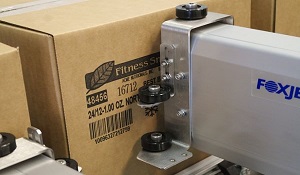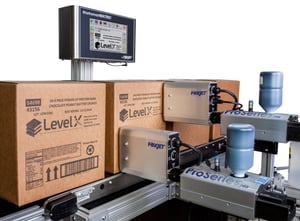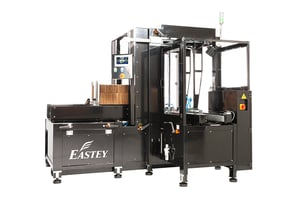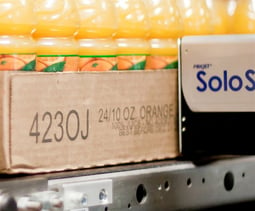
Ensuring a Smooth Production Line from Case Sealer to Case Coder
Across industries, companies have experienced an increase in SKUs, shorter shelf lives for their products, and increased demand for production changeovers. As a result, case coding has become significantly more important in helping the supply chain and logistics function of businesses, allowing manufacturers to track their product as it transitions from supplier to store.
Case coding also plays a role in helping businesses brand themselves, letting companies print a graphic or product information on the side of boxes that immediately identifies where that box has come from and its contents.
The printed texts, graphics, and barcodes have to be accurate to ensure that the logistics process runs smoothly. But if there’s an issue with printing, the code can become illegible. This is especially difficult as boxes move from a tape case sealer or hot melt glue case sealer to coder — during this process, codes are vulnerable to misprints due to material handling, debris from the case sealer getting onto the
printhead, and more. From there, businesses lose track of data, turning into problems with product integrity, transparency, reputation, and even costly potential legal matters.
Luckily, there are some simple steps manufacturers and plant managers can take to prevent their codes from being smeared, smudged, or otherwise unreadable. When manufacturers prioritize seamless integration between their case sealers and case coders, they enhance the efficiency and reliability of their supply chain and logistics operations.
WHAT TO LOOK FOR IN AN INDUSTRIAL CASE CODER
 A single compromised case code can trigger significant operational and financial repercussions for an organization. Beyond the expense associated with reprinting, issues in case coding often disrupt production workflows, leading to delays in order fulfillment and dissatisfied customers. These disruptions can prompt customers to seek alternatives, resulting in lost business, negative feedback, and ultimately, lasting damage to reputation and revenue streams.
A single compromised case code can trigger significant operational and financial repercussions for an organization. Beyond the expense associated with reprinting, issues in case coding often disrupt production workflows, leading to delays in order fulfillment and dissatisfied customers. These disruptions can prompt customers to seek alternatives, resulting in lost business, negative feedback, and ultimately, lasting damage to reputation and revenue streams.
However, it is critical to recognize that without a high-performance case coding printer as the foundation, efforts to maintain equipment and optimize your production line may not yield meaningful results. With a wide array of models and specialized features available, selecting an industrial case coder tailored to your operational requirements can be a complex process. But it doesn't need to be!
Start by clearly defining your operational requirements. Below, you’ll find a checklist designed to help you evaluate and effectively compare case coders.
Will it provide your business with true value?
- Is barcode readability maintained across your end-to-end supply chain?
- Does the case coder support barcode printing that complies with current industry regulations?
- Can the system encode real-time production data, such as date and time, directly into each printed message?
While pre-printed barcodes provide high-quality marks, maintaining extra box inventory increases storage costs and risks waste with every SKU changeover.
How durable is the printer?
Evaluate the construction of your printer components to ensure long-term reliability and minimize downtime. For example, stainless-steel nozzles are built to withstand demanding environments, resist wear, and deliver consistent print quality. These can be refurbished rather than entirely replaced, unlike printers that use plastic face plates.
Can it fulfill your entire company's needs?
Engage all key departments—maintenance, marketing, engineering, and IT—early in the evaluation process. Maintenance and engineering teams should assess technical servicing and operational reliability, marketing should review print quality and branding, while IT must ensure seamless integration with product databases and message creation software to support centralized production management.
Does the printhead's controller software integrate with your database?
Case coding messages were restricted to proprietary formats or created directly within the software. As the number of SKUs and design variations has grown — from dozens to thousands across multiple brands — modern operations now require case coders that can seamlessly integrate with a range of product information management (PIM) databases. The right case coder should enable quick access to accurate product data and brand assets, streamlining message creation as product lines evolve.
COMPLICATIONS WITH CASE CODING AND SEALING DURING MATERIAL HANDLING
Whether you’re purchasing a brand-new case coder or you’re still working with the one you have now, it’s important to keep in mind how your warehouse is set up to ensure your case coding works at an optimal level. If you don’t, you’re more likely to run into issues with material handling which could make your code unreadable or even damage the product inside your cases.
Your entire manufacturing production line relies on a smooth transition from machine to machine. Here are just a few things to consider when avoiding code degradation after the case is sealed:
Proximity to the Industrial Inkjet Printer
If the box isn’t close enough to the case coder, it might not print at all. But if it’s too close, it could mistakenly impact the case coder, making the barcode wavy and unreadable or worse damage the case coder. Inconsistent control of how the box is presented in front of the inkjet coder, especially if the box is not squarely taped or glued, can quickly become problematic, especially as the case transitions from the case sealer to the case coder.
The Speed of the Printhead
If your case sealer distributes faster than your case coder can print, then you’ll likely see misprints — the printing itself might come out distorted or skewed as well as potentially skipping the print on some boxes entirely.
Angel Hair and Other Debris
Old or mis-adjusted hot melt sealers might leave angel hair that can interfere with case coding by becoming stuck to the printhead. Plus, there’s usually debris in the factory itself, and that debris can adhere itself onto the box or printhead. Inkjet printheads have small nozzles that eject tiny droplets of ink all at once, so dirt and angel hair can easily clog the machine if the printhead isn’t maintained. Unfortunately, the longer debris sits on a printhead, the harder it is to clean, so when debris goes ignored, the worse the code becomes and the more expensive it is to maintain the printhead. Often times you must look up-line to track down root cause of poor print. A clean running hot melt adhesive system is important to the health and operation of the entire packaging line.
Carton Control
If your case sealer doesn’t have good control of the carton, then your box might come out misshapen or oblong. And once that happens, the information you need printed will be impacted.
Another common issue is with inconsistent product orientation on the conveyor system. Misaligned cartons can lead to print surface being too far from the printhead, This is easily corrected with some additional conveyor railing and the use of printhead retractable bracket.
Minimizing Vibrations
Strategic placement of your case coder in relation to the case sealer or conveyor transition is key. The vibration that occurs during the case sealing and conveyance process can impact code quality. Each step in the production chain impacts the rest downstream. Having a case transportation method between each piece of equipment allows each piece of equipment adequate space and timing to complete its process with minimal disruption down the production line.
Additionally, its always preferred to mount the printer directly to the floor to mitigate any potential vibrations from worn conveyors. Sometimes this vibration and noise can be subtle but still impact print quality.
BEST PRACTICES FOR MAINTAINING YOUR INDUSTRIAL INKJET PRINTER FOR CASE CODING APPLICATIONS
Secondary packaging is absolutely vital to a manufacturing plants over all productivity. While it can easily be overlooked, case coding it is essential to keep product moving out the door and your customers happy. Use these best practices to maximize up-time and keep your codes looking crisp:
Train your technicians.
While the goal is to have as few interventions as necessary with your inkjet or sealing equipment, a backup plan after having it installed is crucial to guaranteeing no surprises down the line. Your in-house technicians should be trained on maintaining the equipment to keep it working. With every install, there should always be one or more operator training classes to ensure your team is up-to-date on the printer’s needs. After training classes, a good partner will provide you with an easy-to-follow operation’s
manual to ensure best practices are followed. Pak-Tec offers on-site and off-site training courses. We also provide preventative maintenance contract .
Cleaning materials make a difference.
It’s not uncommon for operators to be inclined to continue using the same fluids they’ve always used. When a certain cleaning fluid or ink comes recommended to keep a machine running, it’s because other fluids could create problems such as causing corrosion on your printer parts. Always listen to the trainers to ensure the longevity of a
piece of equipment.
Guarantee proper material handling
If your case sealer doesn’t properly seal or conveyors are in poor working condition, then your case coding printer won’t create a clear print. Industry-leading high resolution
inkjet coders can guarantee consistent control by adding retracting brackets to help the printer adjust even when a box is over-stuffed. A quality-built case coder can go a long way to ensure your case is ready for printing.
Mind the gap
You want to avoid positioning a case coder right at the transition point from a case sealer because you don’t want printing to happen while the case is still being taped or glued. Instead, if room allows, you’ll want to both add a belted conveyor and ensure there’s a gap between boxes.
A small, powered, belted conveyor between your case sealer and case coding printer will help control the flow of cases. Also, use a sealer that is side-belt driven — this will help the box keep its shape for printing without creating too much pressure at the top. The rule of thumb is to maintain a two-product gap — i.e., space for one box in front and one in the back — so that the coder won’t ruin the printing on the next box by accidentally hitting it.
CHOOSE A PARTNER YOU CAN TRUST
Your company has more important things to worry about than constantly stressing over the quality of the codes on your cartons. But if your material handling process isn’t set up efficiently — if transitioning the product from the case sealer to your case coder is not properly set up, for example — then you’ll only see more problems. Instead, follow the best practices within this whitepaper to ensure your product identification efforts
aren’t impacted down the line.
 FoxJet’s high-resolution ProSeries printheads offer unmatched reliability and scan-ability from a large character case coder. The FoxJet ProSeries printheads utilize the only repairable print engines on the market — Trident print engines — and can create complex graphics up to 4” tall. This is ideal for replacing 4x6 labels on your cases and cartons. For barcoding, the ProSeries 384e is the go-to printhead — not only guaranteed to be readable but can handle cases moving at the highest of speeds. FoxJet ProSeries enhanced printheads set the standard for print quality and printer performance in the industry.
FoxJet’s high-resolution ProSeries printheads offer unmatched reliability and scan-ability from a large character case coder. The FoxJet ProSeries printheads utilize the only repairable print engines on the market — Trident print engines — and can create complex graphics up to 4” tall. This is ideal for replacing 4x6 labels on your cases and cartons. For barcoding, the ProSeries 384e is the go-to printhead — not only guaranteed to be readable but can handle cases moving at the highest of speeds. FoxJet ProSeries enhanced printheads set the standard for print quality and printer performance in the industry.
Pak-Tec is extremely proud of our world-class product offering; however, we know the true difference-maker is the service and support we offer to the customer. We have a brilliant team of career professionals that take pride in going the extra mile and it shows every day. Our founding principle is that customer happiness and trust is paramount; it is at the forefront of every action we take and every decision we make.
Looking for more information? Check out the PMMI ProSource directory for additional industry articles.
Related Article: Seven Tips For Coding & Marking Setup



